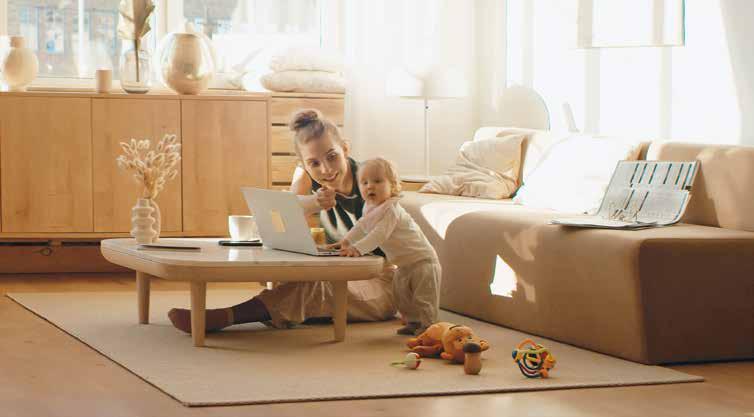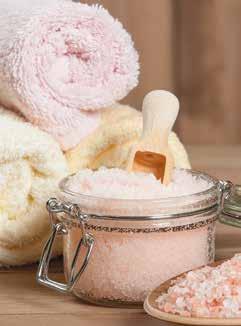
12 minute read
RESILIENT MOTHERING
How Moms Are Forging Ahead in a Changing World
by Carrie Jackson
Two years after “coronavirus” became a household word, the pandemic continues to affect every aspect of our lives. Mothers, in particular, have learned to reimagine what it means to be a parent, employee, partner and friend, while still finding time for themselves. According to the Kaiser Family Foundation, almost 70 percent of mothers say that worry and stress from the pandemic have damaged their mental health.
While social distancing, quarantining, remote learning and masking quickly became a new and often unwelcome normal, positive shifts have also been developing. Already resilient mothers are exploring how to adapt to an ever-changing situation and learning when to hold on and when to let go. They are discovering new ways to be available for their children’s mental health, maintain their jobs, stay connected with other moms and prioritize self-care.
Shae Marcus, publisher of Natural Awakenings South Jersey (NASouthJersey.com), says that the pandemic has brought a number of unforeseen silver linings. As a single mother of two young children, she has been in a constant state of transition the last two years and is starting to achieve greater balance. “Like most other mothers, my life before the pandemic was nonstop. I was getting by, and at the same time comparing myself to other parents. The world had to slow down so I could catch up, and I’ve been forced to stop, breathe and take it in stride,” she says.
Marcus shares a common concern, that the isolation has affected her kids’ development. “I worry that the lack of social integration over the past two years will have a lasting impact on my children. My son, who is now in third grade, was in kindergarten the last time he had a full year in a ‘normal’ school setting. That’s a lot to miss out on. While he is academically on track, I’m concerned about him being mature enough. Having sports and other extracurricular activities starting back now is helping to get them integrated again, and I’m able to fully appreciate going to an outdoor spring football game that wasn’t able to happen for so long,” she says.
Marcus has discovered that working from home has had advantages. “Now, I can do a load of laundry in-between meetings, go to the grocery store when I would have been commuting and be more present when my kids are home. Since I’m not worried about rushing out the door, we have time to talk during breakfast, and I’m able to accompany them to the bus stop. Afterwards, I take 10 minutes for myself to walk around the block and gather my thoughts for the day,” she explains.
Reordering Priorities
Seventy-one percent of mothers describe being a working mom during the pandemic as very challenging, according to research done by the global consultancy group APCO Impact. As president of Families and Work Institute (FamiliesAndWork.org), a New York-based research nonprofit, Ellen Galinsky has seen employers grant access to a wider variety of benefits that fit their employees’ individual and family needs. “The pandemic, coupled with racial reckoning, has made many of us rethink our priorities. It now is becoming clear that the world that seemed relatively normal before wasn’t working. Mothers and fathers were thrust on the front lines of schooling and saw firsthand how different teaching and parenting are,” Galinsky notes.
An estimated 82 percent of employers plan to allow their employees to keep working remotely after the pandemic, reports a survey by human resources consultancy Mercer, but that turnaround is just a first step, says Galinsky. “Studies show that having workplace flexibility procedures in place is a floor, but how employers treat you when you need that flexibility matters the most. The pandemic made us all experience collective and multiple losses together and brought some difficult issues to light,” she explains. In juggling work and life duties, Galinsky shies away from the word “balance”, which suggests that time and energy needs to be split evenly. “Work and home lives are deeply intermingled, and often when one is in sync, the other will follow,” she says. “It’s important for mothers to set realistic expectations for themselves and let go of the notion that they’re not doing a good job, their kids have to be perfect or they don’t have time to take care of themselves. Children will absorb what they see, so being mindful in your words and actions around work will have an impact on them. If you have a stressful meeting and bring that home with you, the energy in the house will change. It’s okay to tell the kids that you’re upset at your boss and are going to call a friend and talk or go
Stress Survival Skills
The pandemic also put many mothers in a chronic state of hypervigilance, because they not only had to manage their own anxiety, but also help kids manage their experiences. A University of Rochester study of 153 mothers of toddlers found that ongoing strains can disrupt the body’s natural stress response, making it more difficult to respond with patience and sensitivity to a child’s needs.
Elizabeth Cohen, a clinical psychologist and director of the Center for CBT (cognitive behavioral therapy) in New York City (Center ForCBTInNYC.com), says that a shock to the nervous system can only be released with the acknowledgement that the trauma is being experienced in the first place. “Having an understanding of how you’re responding to this stress and uncertainty is key to moving through it. Even going back to the office after
SELF-CARE FOR STRESSED-OUT MOMS
For mothers trying to juggle it all, making their own mental health a priority is key. Here are some practical ways busy moms can incorporate their overall wellness into a daily routine.
Set Up Self-Care: Sneaking in breaks throughout the day can have a positive cumulative effect. Follow a guided meditation while waiting for soccer practice, use essential oils in the car, keep a favorite lotion next to the bed or savor a favorite nourishing snack.
Cultivate a Network: Nurturing relationships with supportive peers can provide emotional and social support. Meet a friend for a morning coffee or afternoon walk, join a book club, host a potluck with other mothers or volunteer with a community group.
Prioritize Therapy: The right therapist can provide an unbiased and supportive perspective and help process new and lingering issues. Find a practitioner that understands a mom’s unique needs and a modality that resonates with us. Traditional talk therapy works well for some, but be open to exploring other forms, such as movement therapy or art therapy.
Keep Communication Open: Modeling and encouraging dialogue gives kids a safe space to practice sharing and lets everyone feel valued. Find time during car rides, at the dinner table or before bed to check in with the family and share each other’s thoughts.
Take a Class: Learning a new skill can spark creativity and help build a social network. Try a pottery workshop, join a dance club, take a photography class or study a foreign language just for fun.
so long may trigger a panic attack if the trauma of the past two years isn’t addressed,” she says. “Mothers need to practice compassionate awareness for themselves and what they’ve gone through. They need to be seen, heard and witnessed in the same way their children are.”
Cohen advises that while part of a mother’s job is to make kids feel emotionally safe, it’s not as effective if they are themselves depleted. She recommends adopting simple, actionable practices throughout the day to help restore and reset the mind and body, suggesting, “Put some Epsom salt in the bottom of the tub and allow your feet to soak for a few minutes during a shower. Before brushing your teeth, take three deep breaths and pay attention to where you might be feeling tension in your body. Keep a gratitude journal handy to reflect and record your observations and interactions.”
She advises us to remember that we have all had different experiences of this trauma, and nobody is the same as they were in 2019. “It’s okay to tell a friend, ‘I’m excited to see you and also, I’m uncomfortable not wearing a mask.’ We’ve also had to be more selective about who we spend time with, and that has allowed us to foster more nurturing relationships,” she says. “Be more discerning about who you spend time with, instead of saying yes to every invitation to get coffee. It’s okay to do less, and making authentic decisions in the moment will help you truly feel aligned with your thoughts and actions.”
Joint Healing
Claire Zulkey, a Chicago-based writer and mother of two young boys, has found creative ways to stay connected with other mothers and not feel so isolated. She pens a newsletter, Evil Witches(EvilWitches. substack.com), which gives her a platform to share stories of everyday motherhood triumphs and concerns. Topics have included perimenopause, end-of-life options for the family pet, finding the best hand lotion and other subjects that mothers in her circle think about. She also maintains a Facebook group of 100-plus mothers, providing a safe place for members to commiserate and support each other. “The group has allowed me to really get to know mothers in a more intimate way, truly understand what they’re going through and appreciate how much they care about their kids,” says Zulkey. She made a personal decision to stop drinking a few months into the pandemic, a lifestyle choice that she has maintained for the past year. “While I was not an alcoholic, there were too many times when I would wake up with a hangover or get into a tipsy argument with my husband. I quickly learned to appreciate how much easier parenting is when I’m in a stable mood, and the entire household has benefited, especially during the pandemic, when we were in such close quarters,” she says. For all of us, moving forward after two years of collective grief, loss and uncertainty will undoubtedly present new unforeseen challenges, yet maintaining a sense of perspective can help if things start to feel overwhelming. “At the start of the pandemic, I started to feel sorry for myself, but soon I realized that I actually was so much better off than a lot of people. Once I oriented myself with that reality, it was easier for me to move on with a sense of gratitude and desire to help others,” says Zulkey.
Carrie Jackson is an Evanston, IL-based freelance writer and frequent contributor to Natural Awakenings magazine. Connect at Carrie JacksonWrites.com.


Sports-Related Concussions on the Rise
Sports-related concussions are on the rise among high school athletes. One in four has suffered from a concussion according to an article in U.S. News. Many athletes want to return to play as soon as possible after a head injury, but it may be unclear when they can safely return to play. Those decisions are not black and white. Athletes can experience ongoing symptoms of: brain fog, lack of focus and concentration, anxiety/depression, headaches, fatigue, balance and coordination issues and other symptoms due to their injury. Returning to play too soon can be detrimental.
WAVi EEG brain scanning technology can measure brain imbalances associated with trauma. By objectively measuring the electrical activity in the brain, the scans illustrate a clear picture of brain function in real time. If imbalances are seen, treatment recommendations can be given to help the athlete recover. WAVi is a useful tool to aid in decisions regarding an athlete’s safe return to play status.
Dr. Ramona Pleva is the owner of Northern Lights Chiropractic, located at 510 Depot View Dr., Ste. 13, in Traverse City. For appointments and more information, call 231.668.5050 or visit ramonaplevadc.com. See ad page 17.

DIY Salt Scrub
with Himalayan Salt and Essential Oils

A sea salt scrub is an easy and inexpensive way to maintain a glowing complexion. Salt scrubs work hard to exfoliate and remove dry skin from the surface, reduce the appearance of wrinkles and pores, and improve the overall tone. Exfoliating scrubs are good for the entire body, especially dry areas like feet and hands. They are easy to make because they are a simple combination of salt and oil.
In addition to standard sea salt, adding Himalayan pink salt to a scrub recipe adds an extra boost of health because it contains 84 trace minerals and nutrients. Grapeseed oil, which can be found at natural grocery stores, is a good carrier oil for a scrub because it is extremely nourishing. Adding both almond and jojoba oils, and vitamin E into the mixture increases the scrub’s moisturizing effect, making it especially good for dry skin. Essential oils add fragrance and healing qualities to the scrub, and they can include such variations as:
Margarita salt scrub: 12 drops lime essential oil, 8 drops orange essential oil Rose salt scrub: 15 drops rose essential oil, sprinkle with dried rose petals Citrus burst salt scrub: 5 drops orange essential oil, 10 drops grapefruit essential oil DIY SALT SCRUB RECIPE 1 cup finely ground sea salt ½ cup Himalayan pink salt 4 Tbsp grapeseed oil 3 Tbsp almond oil 1 Tbsp jojoba oil 10 drops vitamin E 15-20 drops essential oil Put sea salt and Himalayan salt into a mixing bowl. Add in grapeseed oil, almond oil, jojoba oil and vitamin E. Add the essential oils last, right on top of the other oils. Mix until all of the salt is coated with oil. It should not be swimming in oil, just coated. Store in a glass or metal container. This recipe fills a single, pint- sized Mason jar or two half-pint jars. Because this salt scrub recipe does not contain any water, it will last up to six months. Make sure to keep it sealed in a jar with a lid to ensure it stays fresh and free of contaminants. If it is kept in the shower, store the scrub away from the water stream.
For more healthy DIY recipes, along with natural skincare and eco-friendly home and garden ideas, visit EcoLivingMama.com.
$10 OFF
your first order with code 68754
Weight-Loss with an EDGE!
MOOD MOTIVATION METABOLISM

Why You Need It!
•Weight loss support •Improves gut health •Reduces bloating & inflammation •Regulates appetite & cravings •Boosts motivation & improves mood •Progressive anti-aging benefits
What It Is!
•Amare GBX FIT: The world’s first QUADbiotic gut-brain axis product for weight loss •Combination of a specific prebiotic, probiotic, phytobiotic, and postbiotic targeted for weight loss in a cool and convenient purple pill •Amare EDGE: Mango Fruit (motivation), Lychee Fruit (metabolism), and Palm Fruit (mood) in a delicious sugar-free and caffeine-free drink •Sustainably sourced ingredients We are a Holistic Mental Wellness Company. GET YOUR EDGE TODAY! Call 734-344-2339 NOW!





